Anjum Anand’s tips on spicing up any Indian meal
ANJUM Anand shares her simple rules for adding flavour to savour with Dan Stock.
Best of Melbourne
Don't miss out on the headlines from Best of Melbourne. Followed categories will be added to My News.
ANJUM Anand, the British-Indian food writer says there are many misconceptions about Indian food.
“People think it’s really unhealthy food, but it uses all these amazing ingredients: ginger, turmeric, garlic, tomatoes,” she says. “It’s always a very balanced meal, it always has some vegetables, some protein, some carbohydrates, often whole wheat breads, and it’s all freshly made.”
The host of last year’s SBS series Anjum’s Australian Spice Stories and author of eight cookbooks, including the recently released I Love India, says one of the biggest fallacies about the cuisine of her heritage is that it’s always heavy, filled with cream and hard to cook at home.
GREAT TIPS FOR ASIAN-STYLE PORK
“At home we never use cream in a curry because it dulls all the flavours, all the lovely spices,” she says.
Ah yes, spices.
It’s hard to think of a cuisine that makes greater use of a bigger range of spices, and this is the reason, for many home cooks, Indian gets relegated from the kitchen to the takeaway menu.
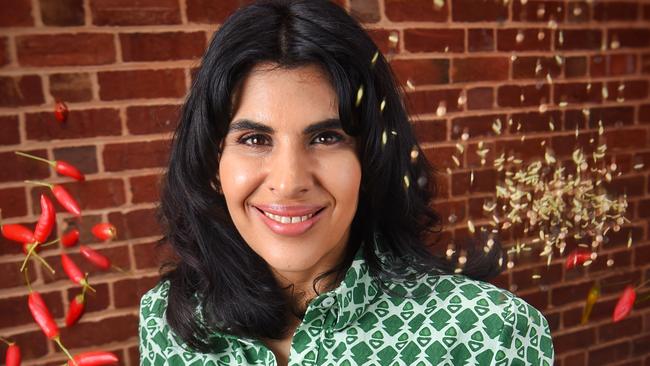
GET STARTED
Anjum has one piece of advice for the cook nervous about jumping into the world of Indian spices.
“Choose something to cook that feels quite familiar. If you love a barbecue, for instance, choose a tandoori chicken, because you know chicken, you understand the barbecue, so it’s just the marinade that’s different,” she says.
That way you can dip your toe into the world of spice and the array of Indian flavours in an easy, familiar way. It’s a great way to build confidence – and cooking any type of cuisine is all about confidence.
“If you’re going to delve into a complicated biryani as your first dish, and it doesn’t work it’s easy to say, ‘I knew I couldn’t cook it’ and give up, and that’s not the case. Anything can be learnt.”

RULES OF ENGAGEMENT
The first thing to do is stock the pantry with fresh spices.
“Try not to buy powdered spices from the supermarket,” Anjum says.
“When you cook a fresh spice in oil, it releases all the volatile oils within the spice, but when you buy powdered spices, the manufacturer has dry roasted them to help them grind, so you lose some of the volatile oils.”
This means they become less potent and leave a powdery finish on the palate, Anjum says.
Once bought, always keep your spices out of sunlight and in airtight containers.
OUR FOOD AND WINE GAME-CHANGERS
“If you do this, your whole, fresh spices will keep for a year. And it means you’ll get the best flavour in your dishes.”
The key to cooking Indian, like any cuisine, is to look for good-quality ingredients and then treat them well.
“People understand this with other cuisines. With Italian people buy the best tomatoes, the best olive oil, but with Indian people buy bog standard stuff and then wonder why their cooking doesn’t taste great.”
PRACTISE PATIENCE
When cooking a curry, Anjum says a little bit of patience goes a long way.
Once you’ve added spices to the onion and tomatoes, for instance, you have to wait for the oils in the spices to release. This takes time. “If your spices taste harsh, they aren’t cooked. If it makes you cough, you’ve added too much of something or it’s not cooked enough. Spices should be very harmonious.”
CUMIN READY OR NOT
One of the most versatile spices to add to your arsenal, cumin works across a broad spectrum of dishes, complementing meat, fish, vegetable and chicken-based meals.
“People are familiar with cumin, so it feels less scary than other spices,” Anjum says. “Dry roast and grind it and it adds a next level of flavour.”
Fry cumin seeds at the start of a curry to add a deep nutty, earthy character. Crush dry roasted seeds and add to yoghurt to make raita, sprinkle across roast potatoes and finish with a spritz of lemon, while cumin-flavoured chicken is a favourite in Anjum’s house.
PLANT A (MUSTARD) SEED
Mustard seeds are the tiny dried seeds from the flower of the mustard plant and come in three colours: brown, black and pale yellow.
Anjum says that when they are fried they develop a deep nuttiness and when ground release a strong mustard pungency that can then be used in a variety of dishes.
Fry brown mustard seeds in hot coconut oil – once they “pop” they are ready – and then use the seeded oil in lentils, use it to dress potatoes, or with chicken.
“In Bengal, they grind the dried mustard seeds and that goes into 80 per cent of dishes,” Anjum says. Whole seeds are nutty, but once ground become tangy and mustardy.
“The tanginess of mustard works wonderfully with fish, where it can be used like lemon.”
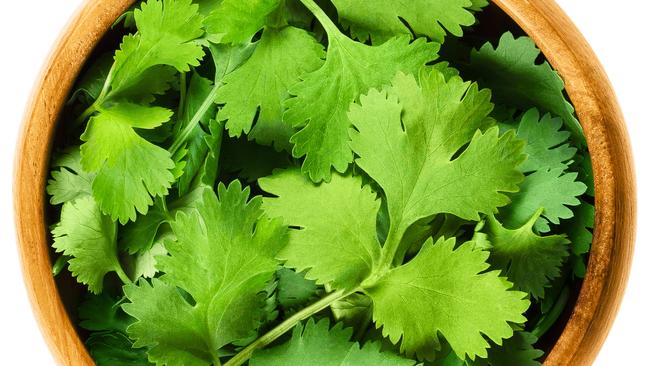
LEAF IT ALONE
Coriander is a must-have spice, used across India.
Dry roasted seeds have a vibrant fresh zingy flavour that is very different to the leaf that most are familiar with.
“It’s really important to Indian food, and is used to thicken the curry,” Anjum says, but cautions that a little goes a long way.
“Add it to certain chicken curries, or a fish curry. When you bite into it, it’s lovely. It’s not overpowering but adds an interesting flavour dimension.”
TURN ONTO TURMERIC
Long before hipsters were adding it to lattes and morning porridge, Indians were using turmeric for its medicinal, healing properties. Anjum says the new adopters are doing it wrong.
“It’s great that people now have an understanding of the medicinal properties of turmeric, but you only absorb the curcumin (the active ingredient) properly if you pair it with black pepper and fat. That’s the best way to get the benefits of turmeric. So a curry is the best.”
Anjum says getting the best out of adding turmeric to your diet is simple: “little and often”.
Said to be antibacterial, antiviral, antifungal, it can be used as a salve on cuts, as a gargle for sore throats, and as a preventive when the first signs of a cold strike.
“Warm some milk with black pepper, turmeric and a touch of honey,” Anjum suggests to ward off the sniffles.
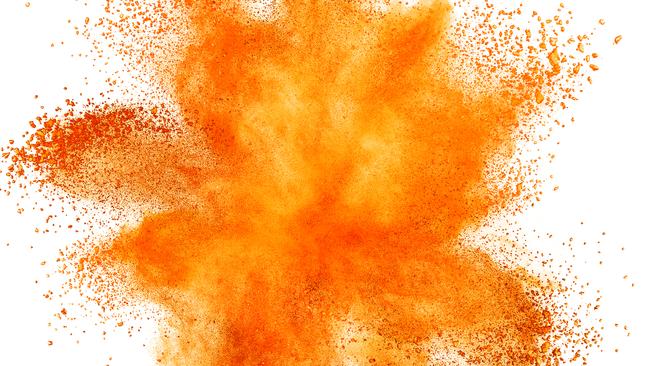
ALL FENUGREEK TO ME
The seeds of the fenugreek plant are used sparingly in Indian cooking as their bitterness can be overpowering. “But the leaves have the most wonderful aromatics and, when dried, don’t have quite the same bitterness,” Anjum says.
The dried and powdered leaves are great to add to potatoes, lentils, cauliflower, paneer (Indian cheese) and chicken.
DON’T LEAF A CURRY
Forming the Holy Trinity of South Indian flavours along with mustard seeds and coconut, curry leaves are a fragrant, unique addition to many dishes. Found in Indian supermarkets, they are at their best fried in hot oil until crisp. The leaves and oil can then be poured over the dish just
before serving.
They can also be used dry – take them off the stalk and dry on kitchen towel. Store in an airtight container and use over the next two months.
PEPPER UP
Anjum says humble black pepper is the most underrated spice and deserves a greater position in our cooking vocabulary.
“Everyone’s so used to having it on the table in the most powdery form, it gets overlooked,” she says. “But I think good black pepper can transform dishes.”
The key, of course, is to always grind your own as you need it and “never ever buy powdered pepper”.
“One of my favourite dishes when I was growing up was my mother’s black pepper chicken and she’d crush a whole tablespoon of pepper in it. It’s so fragrant.”
MIX IT UP
Masala simply means a mix of spices, so garam masala, the most famous Indian spice blend means “hot/warming spices”. While the blend varies from region to region and home to home, Anjum’s mix is a complex blend of black pepper, cloves, cinnamon, Indian bay leaf, black cardamom, mace, nutmeg, coriander and cumin.
She says it’s worth going to the effort of making a batch as garam masala made from fresh spices is the surest way of elevating any dish and will keep for up to three months.
Its main use is in curries but can be added to gravy with roasted lamb, or even used in a glaze for baked ham.
CHAI HARDER
Now a mainstay in cafes across the country, chai is an increasingly popular drink made from black tea, milk and spices. And it’s easy to make at home.
“I don’t put cinnamon in my chai,” Anjum says. “I just take tea, milk, lots of fresh ginger and green cardamom, perhaps a bit of black pepper in the winter and that’s it.”
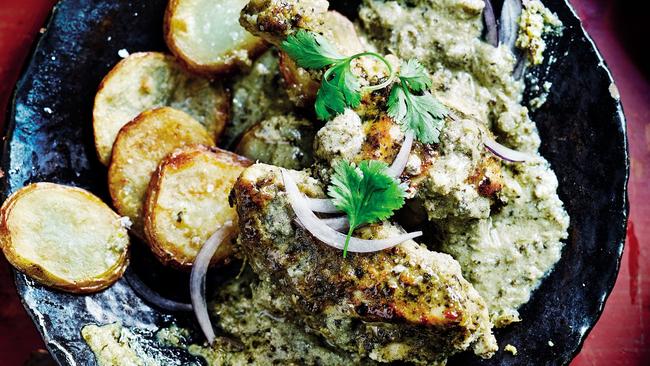
HYDERABAD BAKED HERBY CHICKEN KORMA
Serves 4-6
20g roughly chopped root ginger (peeled weight)
6 large garlic cloves
275g (1 cup) Greek yoghurt
Salt and freshly ground black pepper
8 medium-small, bone-in, skinless chicken pieces (around 1.2kg)
4 tbsp desiccated coconut
Vegetable oil
2 medium-large red onions, finely sliced
40g coriander leaves and stalks, plus more to serve
20g mint leaves (around 40g with stalks)
1 rounded tsp garam masala (fresh if possible)
2 tsp lemon juice, or to taste
2–4 green chillies, stalks removed, pierced with a knife
4 tbsp light cream
1 Blend together the ginger, garlic and yoghurt and 1 tsp salt. Rub this under the skin of the chicken and leave to marinate for 1 hour, if possible. Pound the coconut in a mortar and pestle until it is powdery.
2 Heat 4cm of oil in a smallish saucepan over a medium heat. Add the onions and fry until golden and crisp on the edges. Drain the oil and set aside.
3 Set aside a quarter of the onions and place the rest in the same blender container as you used for the yoghurt mixture (no need to wash) along with 2 tbsp of the cooking oil (use the rest for cooking another dish, it will taste of delicious fried onions), the herbs, coconut, garam masala and lemon juice. Blend until smooth; you might need to add a little water to help
the blades turn. Pour this over the chicken and mix well.
4 Now, leave it for as long as you can to marinate, covered in the fridge, or at room temperature if it is just for 1 hour. If you are in a hurry, you can also just cook it now.
5 Preheat the oven to 180C. Place the chicken and marinade in a large baking dish that can take the chicken in a single, snug layer. Tuck in the chillies, if using.
6 Bake on the middle shelf of the oven until done, 40–45 minutes, basting every now and again. Once done, if the chicken doesn’t have any colour, place on the upper shelf for 5 minutes or so.
7 Stir the cream into the pan juices and mix well. Taste and adjust the seasoning and lemon juice to taste. Serve hot, sprinkled with the reserved onions and extra coriander, along with potatoes, rice or Indian breads.
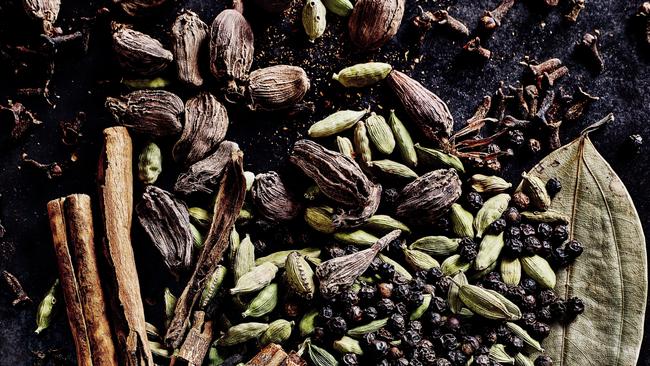
MAKING GARAM MASALA
10g cinnamon sticks
10g cloves
10g green cardamom pods
7g black cardamom pods
2 dried bay leaves
7g black peppercorns
3 pieces of mace
10g cumin seeds
½ nutmeg, grated (optional)
1 Place all the spices except the cumin and nutmeg in a large frying pan over a low heat. Stir often enough that the spices dry out but don’t actually toast – 3–4 minutes.
2 Add the cumin and nutmeg and toast for 30 seconds. Pour straight into a spice grinder and grind until fine. Pass through a sieve over a bowl and discard any coarse pieces. Place these back in the grinder and grind again until fine.
3 Store in an airtight container away from light.
Recipes from an edited extract from I Love India by Anjum Anand (published by Hardie Grant Books) RRP $39.99


